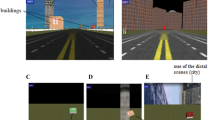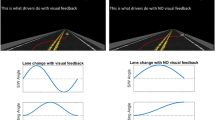Abstract
Can driver steering behaviors, such as a lane change, be executed without visual feedback? In a recent study with a fixed-base driving simulator, drivers failed to execute the return phase of a lane change when steering without vision, resulting in systematic final heading errors biased in the direction of the lane change. Here we challenge the generality of that finding. Suppose that, when asked to perform a lane (position) change, drivers fail to recognize that a heading change is required to make a lateral position change. However, given an explicit path, the necessary heading changes become apparent. Here we demonstrate that when heading requirements are made explicit, drivers appropriately implement the return phase. More importantly, by using an electric vehicle outfitted with a portable virtual reality system, we also show that valid inertial information (i.e., vestibular and somatosensory cues) enables accurate steering behavior when vision is absent. Thus, the failure to properly execute a lane change in a driving simulator without a moving base does not present a fundamental problem for feed-forward driving behavior.












Similar content being viewed by others
References
Bent LR, McFadyen BJ, Merkley VF, Kennedy PM, Inglis JT (2000) Magnitude effects of galvanic vestibular stimulation on the trajectory of human gait. Neurosci Lett 279:157–160
Bertin RJV, Berthoz A (2004) Visuo-vestibular interaction in the reconstruction of traveled trajectories. Exp Brain Res 154:11–21
Carlson AN, Kennedy PM, Anderson KG, Cressman EK, Nagelkerke P, Chua R (2005) Identifying visual–vestibular contributions during target-directed locomotion. Neurosci Lett 384:217–221
Cavallo V, Brun-Dei M, Laya O, Neboit M (1988) Perception and anticipation in negotiating curves: the role of driving experience. In: Gale AG, Freeman MH, Halegrave CM, Smith P, Taylor SP (eds) Vision in vehicles II. Elsevier, Amsterdam, pp 365–374
Deshpande N, Patla AE (2005) Dynamic visual–vestibular integration during goal directed human locomotion. Exp Brain Res 166:237–247
Fitzpatrick RC, Wardman DL, Taylor JL (1999) Effects of galvanic vestibular stimulation during human walking. J Physiol 517:931–939
Godthelp H (1985) Precognitive control: open and closed loop steering in a lane change manoeuvre. Ergonomics 28:1419–1438
Godthelp H (1986) Vehicle control during curve driving. Hum Factors 28:211–221
Grasso R, Glasauer S, Georges-Francois P, Israel I (1999) In: Cohen B, Hess B (eds) Otolith function in spatial orientation and movement. Ann NY Acad Sci 871:345–366
Harris LR, Jenkin M, Zikovitz DC (2000) Visual and non-visual cues in the perception of linear self-motion. Exp Brain Res 135:12–21
Hildreth EC, Beusmans JMH, Boer ER, Royden CS (2000) From vision to action: experiments and models of steering control during driving. J Exp Psychol Hum 26:1106–1132
Kemeny A, Panerai F (2003) Evaluating perception in driving simulation experiments. Trends Cogn Sci 7:31–37
Kennedy PM, Cressman EK, Carlson AN, Chua R (2005) Assessing vestibular contributions during changes in gait trajectory. Neuroreport 16:1097–1100
Land M (1998) The visual control of steering. In: Harris LR, Jenkins H (eds) Vision and action. Cambridge University Press, Cambridge, pp 163–180
Loomis JM, Beall AC (2004) Model-based control of perception/action. In: Vaina L, Beardsley S, Rushton S (eds) Optic flow and beyond. Kluwer, Boston, pp 421–441
Loomis JM, Klatzky RL, Golledge RG, Philbeck JW (1999) Human navigation by path integration. In: Golledge RG (eds) Wayfinding: cognitive mapping and other spatial processes. Johns Hopkins, Baltimore, pp 125–151
Macuga KL, Loomis JM, Beall AC (2004) Two processes in the visual control of steering along a curving path: sensing turns and updating with respect to the path [Abstract]. J Vis 4(8):2a
Riecke BE, von der Heyde M, Bülthoff H (2005) Visual cues can be sufficient for triggering automatic reflex like spatial updating. ACM T Appl Perception 2:183–215
Rushton SK, Harris JM, Lloyd M, Wann JP (1998) Guidance of locomotion on foot uses perceived target location rather than optic flow. Curr Biol 8:1191–1194
Salvucci DD, Gray R (2004) A two-point visual control model of steering. Perception 33:1233–1248
Salvucci DD, Liu A (2002) The time course of a lane change: driver control and eye-movement behavior. Transp Res F-Traf 5:123–132
Wallis G, Chatziastros A, Bülthoff H (2002) An unexpected role for visual feedback in vehicle steering control. Curr Biol 12:295–299
Wallis G, Chatziastros A, Tresilian J, Tomasevic N (2006) The role of visual and non-visual feedback in a vehicle steering task. J Exp Psychol Hum (in press)
Wilkie RM, Wann JP (2005) The role of visual and nonvisual information in the control of locomotion. J Exp Psychol Hum 31:901–911
van Winsum W, de Waard D, Brookhuis KA (1999) Lane change manoeuvres and safety margins. Transp Res F-Traf 2:139–149
Acknowledgments
Supported by AFOSR grant F49620-02-1-0145. Experiments 1 and 2 were presented at the Vision Sciences Society meeting, May 2005. The authors would like to thank Jerry Tietz for technical assistance and Elizabeth Mier for her help in running the experiments.
Author information
Authors and Affiliations
Corresponding author
Rights and permissions
About this article
Cite this article
Macuga, K.L., Beall, A.C., Kelly, J.W. et al. Changing lanes: inertial cues and explicit path information facilitate steering performance when visual feedback is removed. Exp Brain Res 178, 141–150 (2007). https://doi.org/10.1007/s00221-006-0718-x
Received:
Accepted:
Published:
Issue Date:
DOI: https://doi.org/10.1007/s00221-006-0718-x




